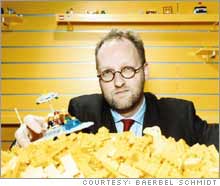|
One brick at a time
Two years ago Lego was broken. Then it got a new CEO and a new approach to making toys - and money.
(FORTUNE Magazine) - Brick by plastic brick, the world of Lego is built on fantasy. Whether it's Viking ships and model houses for kids or high-tech toys for adults that can be plugged into a computer and designed via the Internet, following instructions has always been optional when it comes to arranging the 8,000 interlocking pieces that form the Lego universe. If, like Google (Research) co-founder Larry Page, you wanted to build an inkjet printer from scratch, well, you just built one out of Legos, as Page did in college. That same spirit prevailed for decades at Lego's headquarters in Billund, Denmark. Imagination and creativity, not structure and discipline, were what guided Lego from its founding by carpenter Ole Kirk Christiansen in 1932. Its very name comes from the Danish for "play well": leg godt.
Unfortunately, what makes for a great toy doesn't always make for a great toy company. And by the 1990s, with children turning away from traditional toys in favor of videogames and PCs, Lego had lost its way. Privately held and still majority-controlled by Christiansen's heirs, Lego tried and failed to expand into everything from clothes and computer games to Lego theme parks in the U.S. and Europe. By 2004, Lego was losing hundreds of millions a year, and the company looked as if it might go the way of a once-beloved game now consigned to the attic. Enter Jorgen Vig Knudstorp, a boyish 37-year-old Dane who combines Scandinavian modesty with very American bluntness about the importance of making money and surviving in a world dominated by PlayStations and iPods. Since taking over as CEO a year and a half ago, the former McKinsey consultant has done more than cut jobs (1,000 in Billund alone) and outsource manufacturing to cheaper locales like the Czech Republic. Lego's first leader to come from outside the founding family, Knudstorp has also upended Lego's corporate culture, replacing "nurturing the child" as the top priority in Lego's employee mission statement with "I am here to make money for the company." That might sound obvious to American ears, but in sleepy Billund, with a population of 6,500 who have long looked to Lego as both their chief employer and paterfamilias, it has been a shock. "The company was very focused on doing good - that's fine," says Knudstorp, sitting in a glass-enclosed office surrounded by Lego toys, from big block Duplos for the toddler set to Bionicles, futuristic creations that scarcely resemble the Legos most of us remember. "But the attitude was 'We're doing great stuff for kids - don't bother us with financial goals.' It was a culture where delivering what was promised wasn't critical." Before the crisis of the past few years, says play expert and 22-year Lego veteran Niels Sandal Jakobsen, "money was not something people worried about or talked about." Similarly, toys that smacked of violence or fighting were frowned upon for decades, despite their obvious appeal to boys, who make up most of Lego's customer base. When Lego decided in 1999 to launch a Star Wars series, recalls Jakobsen, "getting the license from Lucas was nothing compared to the internal struggle over having the word 'war' appear under the Lego brand." Knudstorp's cultural revolution also reached into the cultlike quarters of Lego's design team. Development time for new toys has been sliced in half, with the goal of going from idea to box in 12 months. To save on manufacturing costs, Lego has cut the number of pieces, or "elements," as they are known - for example, eliminating different versions of a little chef, some with a mustache, some without. "People had personal relationships with elements," says design director Dorthe Kjaerulff, describing how her staff fought to keep favorites alive but in the end created a memorial to the discontinued pieces, complete with little black crosses. (Only the chef with the mustache survives.) More serious cuts were also made, like selling off Lego's theme parks division for nearly $500 million last summer and reducing Lego's worldwide employment from 7,300 in 2004 to 5,300 today. Lego still employs 1,000 blue-collar workers churning out elements in Billund, and while Knudstorp says he wants to preserve as many of those jobs as possible, the company is scouting out new factories in Eastern Europe. Knudstorp says Lego still has a ways to go, but his efforts appear to be paying off. The company eked out an $87 million net profit last year, after losing more than $300 million in 2004, while revenues rose 12 percent to $1.2 billion. And new games built around Batman comics, Star Wars movies, and Ferrari race cars seem to be connecting with the children of parents who grew up on simple red, white, and yellow Lego bricks.
Although there's more buzz coming from new releases like Mindstorms - featuring chip-enabled elements and downloadable software to build robots - Lego's more traditional games still generate roughly two-thirds of sales. And that's fine with Knudstorp. "Lego is a niche product, with 2 percent to 3 percent of the global toy market," he notes. "Our vision is to be based on the Lego brick - that's our heritage and our future." |
|

